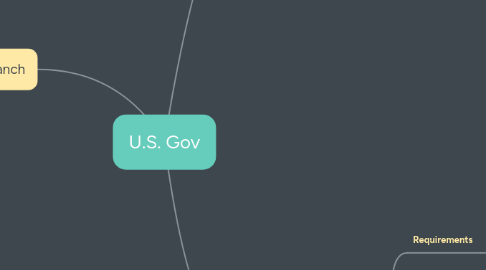
1. Judicial Branch
1.1. Qualifications
1.1.1. There are no official qualifications for becoming a Supreme Court justice.
1.2. How they are selected
1.2.1. Supreme Court nominees, after being selected by the president must be approved by a simple majority vote
1.3. How many Justices
1.3.1. Nine Justices make up the current Supreme Court
1.4. How long do they serve
1.4.1. The average length on the court is 16 years; 49 justices died in office, 56 retired.
1.5. The Powers of Supreme Court
1.5.1. judicial review, or the ability of the Court to declare a Legislative or Executive act in violation of the Constitution
2. Legislative branch
2.1. Chambers of Congress
2.1.1. The House of Representatives and the Senate
2.1.2. Must be 25 years old, U.S. citizen for 7 years, resident of the state they represent.
2.1.3. 100 Senators, 435 Representatives
2.1.4. Make all laws, declare war, regulates interstate and foreign commerce and controls taxing and spending policies
2.1.5. Senate has no limit on terms served, HOR has a 6 year term
2.1.6. Implied powers doctrine and justified by the Elastic Clause are often controversial and hotly debated.
3. Executive Branch
3.1. Requirements
3.1.1. President must be natural born citizen, at least 35 years old, resident of the U.S. for at least 14 years
3.1.2. Vice President must be a natural-born U.S. citizen; be at least 35 years old; be a resident in the U.S. for at least 14 years.
3.2. Terms and Limit
3.2.1. Federal term limits. Limited to being elected to a total of 2 four-year terms. A President by succession who completes more than two years of a former President's unfinished term may be elected in his or her own right only once, and 2 more four-year terms are permitted if they complete two years or less.
3.3. Powers of Executive Branch
3.3.1. Being able to veto, or reject, a proposal for a law. Appoint federal posts, such as members of government agencies. Negotiate foreign treaties with other countries. Appoint federal judges. Grant pardons, or forgiveness, for a crime.
3.4. Roles as President
3.4.1. 1) chief of state, 2) chief executive, 3) chief administrator, 4) chief diplomat, 5) commander in chief, 6) chief legislator, 7) party chief, 8) chief citizen.
3.5. Executive Departments
3.5.1. 15 departments: Secretaries of Agriculture, Commerce, Defense, Education, Energy, Health and Human Services, Homeland Security, Housing and Urban Development, Interior, Labor, State, Transportation, Treasury, and Veterans Affairs,

